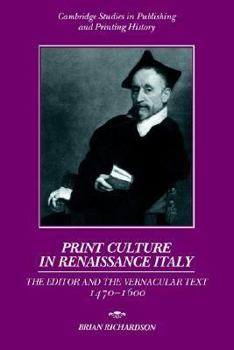Print Culture in Renaissance Italy: The Editor and the Vernacular Text, 1470 1600
(Part of the Cambridge Studies in Publishing and Printing History Series)
Select Format
Select Condition 
Book Overview
The emergence of print in late fifteenth-century Italy gave a crucial new importance to the editors of texts, who could strongly influence the interpretation and status of texts by determining the... This description may be from another edition of this product.
Format:Hardcover
Language:English
ISBN:0521420326
ISBN13:9780521420327
Release Date:June 1994
Publisher:Cambridge University Press
Length:284 Pages
Weight:1.35 lbs.
Dimensions:0.9" x 6.4" x 9.3"
Customer Reviews
1 rating
This is an excellent, dense book
Published by Thriftbooks.com User , 23 years ago
As far as the history of the book goes, Richardson's area of concentration is much more exclusive and circumscribed than, say, Eisenstein's. Rather than attempting to explicate the rise of vernacular literature from the point of view of the demanding reading public in traditional epochal terms, he turns his attention to early Italian editors and attempts to chart the role that they played in creating a wider readership through exegetical, paratextual additions (prefaces, notes, etc.) to various works. The rise of vernacular literature is seen through the narrow lens of pragmatic business decisions. The main themes of his overall inquiry center on the role that editors in Venice and Florence played in transforming the physical presentation of an author's production, their efforts at standardizing a Tuscan-based vernacular, and the cultural rivalries that often emerged between competing centers of print the in the first 150 years of the press. Richardson notes in his preface that the editorial functions of correcting a text and providing "help" for the reader have a history that stretches back to antiquity. However, a style of language that suited one's targeted audience became increasingly important to the success of an edition with the advent of printing and the additional overhead that was incurred in the form of labor, materials, and transportation. Care and thought had to be given to a book's choice of words in order to maximize its audience and its chance at becoming a financial success. With authors of less stature than Petrarch, Boccaccio, Ariosto, and Dante, editors often took great liberty in correcting style and grammar. The editors' efforts, along with their contribution to the publishing of numerous grammatical works, are ultimately construed as helping to standardize a literary vernacular. With the works of the great Italian writers, editors did not take such great liberties. Yet, in attempting to make the reading of these authors easier, glossaries, annotations, summaries, indexes and biographies were added. As the texts of these authors began to serve as exemplars of the expected use of the Italian vernacular, explanations of the Tuscan vocabulary that were often related to spoken regional dialects also began appearing in some editions. Richardson is explicit in holding that these efforts were ultimately quite formative in the expansion of the reading public, but he does not parlay this point into a commentary on the Renaissance, in general. Despite the extremely interesting and nuanced analysis, overall, the style of the book is aimed at the level of an expert, and this is probably not the most productive place to start an examination of the history of publishing.





